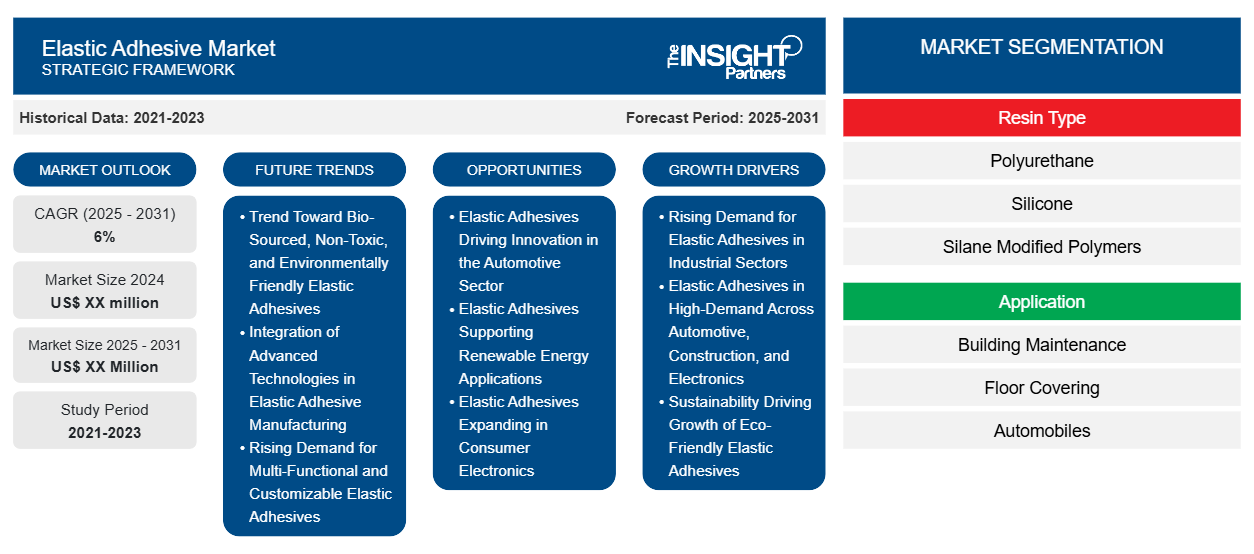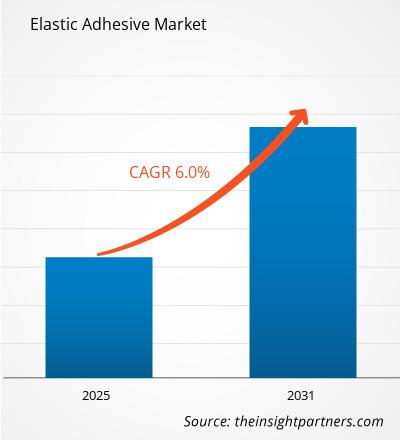Se espera que el mercado de adhesivos elásticos registre una CAGR del 6% entre 2023 y 2031, con un tamaño de mercado que se expandirá de US$ XX millones en 2023 a US$ XX millones en 2031.
El informe está segmentado por tipo de resina (poliuretano, silicona, polímeros modificados con silano (SMP), otros), aplicación (mantenimiento de edificios, revestimiento de suelos, automóviles). El informe presenta además un análisis basado en la industria de uso final (construcción, automoción y transporte, industrial). El análisis global se desglosa aún más a nivel regional y por países principales. En términos geográficos, el mercado se divide en América del Norte, Europa, Asia Pacífico, Oriente Medio y África, y América del Sur y Central). El informe ofrece el valor en USD para el análisis y los segmentos anteriores.
Propósito del Informe
El informe Elastic Adhesive Market de The Insight Partners tiene como objetivo describir el panorama actual y el crecimiento futuro, los principales factores impulsores, los desafíos y las oportunidades. Esto proporcionará información a diversas partes interesadas del negocio, como:
- Proveedores/fabricantes de tecnología: Para comprender la dinámica cambiante del mercado y conocer las oportunidades potenciales de crecimiento, lo que les permitirá tomar decisiones estratégicas informadas.
- Inversionistas: Realizar un análisis exhaustivo de tendencias sobre la tasa de crecimiento del mercado, las proyecciones financieras del mercado y las oportunidades que existen en toda la cadena de valor.
- Órganos reguladores: Regular las políticas y vigilar las actividades del mercado con el objetivo de minimizar los abusos, preservar la confianza de los inversores y defender la integridad y la estabilidad del mercado.
Segmentación del mercado de adhesivos elásticos
Tipo de resina
- Poliuretano
- Silicona
- Polímeros modificados con silano
- Otros
Solicitud
- Mantenimiento de edificios
- Recubrimiento de piso
- Automóviles
Industria de uso final
- Construcción
- Automoción y transporte
- Industrial
Geografía
- América del norte
- Europa
- Asia-Pacífico
- América del Sur y Central
- Oriente Medio y África
Geografía
- América del norte
- Europa
- Asia-Pacífico
- América del Sur y Central
- Oriente Medio y África
Personalice este informe según sus necesidades
Obtendrá personalización en cualquier informe, sin cargo, incluidas partes de este informe o análisis a nivel de país, paquete de datos de Excel, así como también grandes ofertas y descuentos para empresas emergentes y universidades.
- Obtenga las principales tendencias clave del mercado de este informe.Esta muestra GRATUITA incluirá análisis de datos, desde tendencias del mercado hasta estimaciones y pronósticos.
Factores impulsores del crecimiento del mercado de adhesivos elásticos
- Demanda creciente de adhesivos elásticos en sectores industriales: los adhesivos elásticos tienen una gran demanda debido a su creciente aplicación en diversos sectores industriales, como la automoción, la construcción y la electrónica. Los adhesivos elásticos pueden proporcionar una excelente resistencia de unión y flexibilidad, que son resistentes por naturaleza y duran mucho tiempo, según los requisitos de los procesos de fabricación modernos.
- Los adhesivos elásticos son muy demandados en los sectores de la automoción, la construcción y la electrónica: el aumento continuo de la demanda de uniones potentes, flexibles y duraderas, en particular en los sectores de la automoción, la construcción y la electrónica, ha convertido a los adhesivos elásticos en unos de los adhesivos más utilizados en aplicaciones de construcción y automoción en sellado, unión y montaje. A medida que estos sectores se desarrollen debido al crecimiento de la infraestructura y la fabricación de vehículos, la demanda de estos adhesivos elastoméricos aumentará aún más, arrasando con este mercado.
- La sostenibilidad impulsa el crecimiento de los adhesivos elásticos ecológicos: con la creciente demanda de productos ambientalmente viables, los adhesivos elásticos ecológicos están preparados para crecer. Los fabricantes están formulando adhesivos a base de agua, no tóxicos y con bajo contenido de COV, que cumplen con los objetivos de sostenibilidad y las normas regulatorias, lo que se convierte en una fuerza impulsora importante para la expansión de este mercado.
Tendencias futuras del mercado de adhesivos elásticos
- Tendencia hacia adhesivos elásticos de origen biológico, no tóxicos y respetuosos con el medio ambiente: los adhesivos elásticos derivados de fuentes biológicas, no tóxicos y respetuosos con el medio ambiente han ganado una tendencia a desarrollarse. Todos los fabricantes apuntan al desarrollo de sus materiales para cumplir con las regulaciones ambientales y la demanda de los consumidores de alternativas ecológicas y renovables, de modo que no dependan demasiado de los productos derivados del petróleo.
- Integración de tecnologías avanzadas en la fabricación de adhesivos elásticos: una de las principales tendencias que se observan en el mercado de los adhesivos elásticos es la creciente integración de tecnologías avanzadas como la automatización y la robótica. En particular, estas nuevas tecnologías mejorarán la precisión, la velocidad y la uniformidad de la aplicación de adhesivos en diversas industrias, como la automotriz, la construcción y la electrónica, mejorando así la productividad y el rendimiento de los productos finales.
- Demanda creciente de adhesivos elásticos personalizables y multifuncionales: estas demandas están surgiendo rápidamente en la demanda de multifuncionalidad de los adhesivos por parte de los consumidores, por ejemplo, fortalecimiento de la unión, resistencia al agua y flexibilidad. Esto conducirá a la fabricación de adhesivos elásticos hiperpersonalizables en respuesta a necesidades particulares en las industrias del embalaje, automotriz, electrónica y otras similares, ofreciendo a los clientes soluciones personalizadas para una variedad de aplicaciones.
Oportunidades de mercado para adhesivos elásticos
- Los adhesivos elásticos impulsan la innovación en el sector de la automoción: el sector de la automoción está considerando ahora materiales ligeros para que los adhesivos elásticos desplacen las antiguas técnicas mecánicas de unión de piezas. Estos adhesivos proporcionan uniones fuertes y flexibles para el ensamblaje de componentes y, en consecuencia, mejoran la eficiencia y el rendimiento del combustible, lo que se traduce en una mayor demanda en la fabricación de automóviles.
- Adhesivos elásticos que favorecen las aplicaciones de energía renovable: los adhesivos elásticos encajarían perfectamente en este contexto, ya que las fuentes de energía renovable, especialmente la solar y la eólica, exigen un aumento de la producción. El uso de adhesivos elásticos sería ideal en el caso de que los materiales se unan en dispositivos energéticamente eficientes, ya que la flexibilidad, el alto rendimiento y la durabilidad son necesarios para las aplicaciones de energía renovable.
- Los adhesivos elásticos se están expandiendo en el sector de la electrónica de consumo: el mercado de la electrónica de consumo, que está en auge, ofrece grandes posibilidades para las aplicaciones de adhesivos elásticos, como la unión de pantallas, el ensamblaje de componentes electrónicos y las pantallas flexibles, entre muchas otras. De esta manera, se consiguen uniones resistentes y duraderas en diseños compactos y flexibles, y un rendimiento mucho mejor de los productos en una aplicación electrónica, lo que impulsa aún más el crecimiento del mercado.
Perspectivas regionales del mercado de adhesivos elásticos
Los analistas de Insight Partners explicaron en detalle las tendencias y los factores regionales que influyen en el mercado de adhesivos elásticos durante el período de pronóstico. Esta sección también analiza los segmentos y la geografía del mercado de adhesivos elásticos en América del Norte, Europa, Asia Pacífico, Oriente Medio y África, y América del Sur y Central.

- Obtenga datos regionales específicos para el mercado de adhesivos elásticos
Alcance del informe de mercado de adhesivos elásticos
| Atributo del informe | Detalles |
|---|---|
| Tamaño del mercado en 2023 | XX millones de dólares estadounidenses |
| Tamaño del mercado en 2031 | US$ XX millones |
| Tasa de crecimiento anual compuesta (CAGR) global (2023-2031) | 6% |
| Datos históricos | 2021-2022 |
| Período de pronóstico | 2024-2031 |
| Segmentos cubiertos | Por tipo de resina
|
| Regiones y países cubiertos | América del norte
|
| Líderes del mercado y perfiles de empresas clave |
|
Densidad de actores del mercado de adhesivos elásticos: comprensión de su impacto en la dinámica empresarial
El mercado de adhesivos elásticos está creciendo rápidamente, impulsado por la creciente demanda de los usuarios finales debido a factores como la evolución de las preferencias de los consumidores, los avances tecnológicos y una mayor conciencia de los beneficios del producto. A medida que aumenta la demanda, las empresas amplían sus ofertas, innovan para satisfacer las necesidades de los consumidores y aprovechan las tendencias emergentes, lo que impulsa aún más el crecimiento del mercado.
La densidad de actores del mercado se refiere a la distribución de las empresas o firmas que operan dentro de un mercado o industria en particular. Indica cuántos competidores (actores del mercado) están presentes en un espacio de mercado determinado en relación con su tamaño o valor total de mercado.
Las principales empresas que operan en el mercado de adhesivos elásticos son:
- 3M
- Arcama
- Nuevos materiales de Beijing Comens
- Cemedina
- Grupo Celo
Descargo de responsabilidad : Las empresas enumeradas anteriormente no están clasificadas en ningún orden particular.

- Obtenga una descripción general de los principales actores clave del mercado de adhesivos elásticos
Puntos de venta clave
- Cobertura integral: el informe cubre de manera integral el análisis de productos, servicios, tipos y usuarios finales del mercado de adhesivos elásticos, proporcionando un panorama holístico.
- Análisis de expertos: el informe se compila sobre la base de un profundo conocimiento de expertos y analistas de la industria.
- Información actualizada: El informe asegura relevancia comercial debido a su cobertura de información reciente y tendencias de datos.
- Opciones de personalización: este informe se puede personalizar para satisfacer los requisitos específicos del cliente y adaptarse adecuadamente a las estrategias comerciales.
Por lo tanto, el informe de investigación sobre el mercado de adhesivos elásticos puede ayudar a abrir camino para descifrar y comprender el escenario de la industria y las perspectivas de crecimiento. Si bien puede haber algunas preocupaciones válidas, los beneficios generales de este informe tienden a superar las desventajas.
- Análisis histórico (2 años), año base, pronóstico (7 años) con CAGR
- Análisis PEST y FODA
- Tamaño del mercado Valor/volumen: global, regional, nacional
- Industria y panorama competitivo
- Conjunto de datos de Excel


- Electronic Data Interchange Market
- Small Internal Combustion Engine Market
- Industrial Inkjet Printers Market
- Medical and Research Grade Collagen Market
- Airport Runway FOD Detection Systems Market
- Glycomics Market
- Battery Testing Equipment Market
- Diaper Packaging Machine Market
- Smart Locks Market
- Drain Cleaning Equipment Market

Report Coverage
Revenue forecast, Company Analysis, Industry landscape, Growth factors, and Trends

Segment Covered
This text is related
to segments covered.

Regional Scope
North America, Europe, Asia Pacific, Middle East & Africa, South & Central America

Country Scope
This text is related
to country scope.
Preguntas frecuentes
The report can be delivered in PDF/Word format, we can also share excel data sheet based on request.
Based on geography, North America held the largest share of the elastic adhesive market.
3M, Arkema S.A, Beijing Comens New Materials, Cemedine, Grupo Celo, Henkel, Mapei, Sika AG, Wacker Chemie, Weicon are the key players operating in the elastic adhesive market.
On the basis of geography, the elastic adhesives market is classified into North America, Europe, Asia Pacific, Middle East and Africa, and South and Central America.
The increasing need for strong, flexible, and durable bonds in industries like automotive, construction, and electronics is driving the demand for elastic adhesives.
The Elastic Adhesive Market is estimated to witness a CAGR of 6% from 2023 to 2031
Trends and growth analysis reports related to Chemicals and Materials : READ MORE..
1. 3M
2. Arkema
3. Beijing Comens New Materials
4. Cemedine
5. Grupo Celo
6. Henkel
7. Mapei
8. Sika AG
9. Wacker Chemie
10. Weicon
The Insight Partners performs research in 4 major stages: Data Collection & Secondary Research, Primary Research, Data Analysis and Data Triangulation & Final Review.
- Data Collection and Secondary Research:
As a market research and consulting firm operating from a decade, we have published and advised several client across the globe. First step for any study will start with an assessment of currently available data and insights from existing reports. Further, historical and current market information is collected from Investor Presentations, Annual Reports, SEC Filings, etc., and other information related to company’s performance and market positioning are gathered from Paid Databases (Factiva, Hoovers, and Reuters) and various other publications available in public domain.
Several associations trade associates, technical forums, institutes, societies and organization are accessed to gain technical as well as market related insights through their publications such as research papers, blogs and press releases related to the studies are referred to get cues about the market. Further, white papers, journals, magazines, and other news articles published in last 3 years are scrutinized and analyzed to understand the current market trends.
- Primary Research:
The primarily interview analysis comprise of data obtained from industry participants interview and answers to survey questions gathered by in-house primary team.
For primary research, interviews are conducted with industry experts/CEOs/Marketing Managers/VPs/Subject Matter Experts from both demand and supply side to get a 360-degree view of the market. The primary team conducts several interviews based on the complexity of the markets to understand the various market trends and dynamics which makes research more credible and precise.
A typical research interview fulfils the following functions:
- Provides first-hand information on the market size, market trends, growth trends, competitive landscape, and outlook
- Validates and strengthens in-house secondary research findings
- Develops the analysis team’s expertise and market understanding
Primary research involves email interactions and telephone interviews for each market, category, segment, and sub-segment across geographies. The participants who typically take part in such a process include, but are not limited to:
- Industry participants: VPs, business development managers, market intelligence managers and national sales managers
- Outside experts: Valuation experts, research analysts and key opinion leaders specializing in the electronics and semiconductor industry.
Below is the breakup of our primary respondents by company, designation, and region:

Once we receive the confirmation from primary research sources or primary respondents, we finalize the base year market estimation and forecast the data as per the macroeconomic and microeconomic factors assessed during data collection.
- Data Analysis:
Once data is validated through both secondary as well as primary respondents, we finalize the market estimations by hypothesis formulation and factor analysis at regional and country level.
- Macro-Economic Factor Analysis:
We analyse macroeconomic indicators such the gross domestic product (GDP), increase in the demand for goods and services across industries, technological advancement, regional economic growth, governmental policies, the influence of COVID-19, PEST analysis, and other aspects. This analysis aids in setting benchmarks for various nations/regions and approximating market splits. Additionally, the general trend of the aforementioned components aid in determining the market's development possibilities.
- Country Level Data:
Various factors that are especially aligned to the country are taken into account to determine the market size for a certain area and country, including the presence of vendors, such as headquarters and offices, the country's GDP, demand patterns, and industry growth. To comprehend the market dynamics for the nation, a number of growth variables, inhibitors, application areas, and current market trends are researched. The aforementioned elements aid in determining the country's overall market's growth potential.
- Company Profile:
The “Table of Contents” is formulated by listing and analyzing more than 25 - 30 companies operating in the market ecosystem across geographies. However, we profile only 10 companies as a standard practice in our syndicate reports. These 10 companies comprise leading, emerging, and regional players. Nonetheless, our analysis is not restricted to the 10 listed companies, we also analyze other companies present in the market to develop a holistic view and understand the prevailing trends. The “Company Profiles” section in the report covers key facts, business description, products & services, financial information, SWOT analysis, and key developments. The financial information presented is extracted from the annual reports and official documents of the publicly listed companies. Upon collecting the information for the sections of respective companies, we verify them via various primary sources and then compile the data in respective company profiles. The company level information helps us in deriving the base number as well as in forecasting the market size.
- Developing Base Number:
Aggregation of sales statistics (2020-2022) and macro-economic factor, and other secondary and primary research insights are utilized to arrive at base number and related market shares for 2022. The data gaps are identified in this step and relevant market data is analyzed, collected from paid primary interviews or databases. On finalizing the base year market size, forecasts are developed on the basis of macro-economic, industry and market growth factors and company level analysis.
- Data Triangulation and Final Review:
The market findings and base year market size calculations are validated from supply as well as demand side. Demand side validations are based on macro-economic factor analysis and benchmarks for respective regions and countries. In case of supply side validations, revenues of major companies are estimated (in case not available) based on industry benchmark, approximate number of employees, product portfolio, and primary interviews revenues are gathered. Further revenue from target product/service segment is assessed to avoid overshooting of market statistics. In case of heavy deviations between supply and demand side values, all thes steps are repeated to achieve synchronization.
We follow an iterative model, wherein we share our research findings with Subject Matter Experts (SME’s) and Key Opinion Leaders (KOLs) until consensus view of the market is not formulated – this model negates any drastic deviation in the opinions of experts. Only validated and universally acceptable research findings are quoted in our reports.
We have important check points that we use to validate our research findings – which we call – data triangulation, where we validate the information, we generate from secondary sources with primary interviews and then we re-validate with our internal data bases and Subject matter experts. This comprehensive model enables us to deliver high quality, reliable data in shortest possible time.


 Obtenga una muestra gratuita de este informe
Obtenga una muestra gratuita de este informe